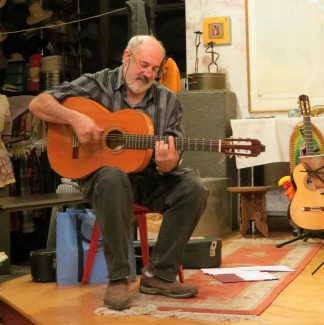Features Reporter
Photo by Charlie Blackmer
Dr. Luis Silva-Villar sits behind a desk covered in papers, folders and books, on top of which rest a few faded record sleeves and a small stack of CDs. The CMU Spanish professor leans forward in his chair and pulls up a YouTube video, smiling as if he has a wonderful secret to tell. The video is from the early 1980s and shows a seven-man band playing a fusion of traditional Spanish-Celtic music and rock that made the group, Labanda, famous throughout Spain in the early 80s.
“Look, there’s me, with the mandolin,” Dr. Silva-Villar says, grinning and pointing at a young man with long, dark hair and a thick mustache, bouncing lightly on stage and plucking the mandolin. He turns and opens one of the old record sleeves, revealing pictures of Labanda in the recording studio in Madrid circa 1979. “And there’s my brother, José Mariá, on the guitar.”

CMU professor, Dr. Luis Silva-Villar, performs at a recent “Poets & Writers of Colorado Mesa University” reading at Planet Earth and 4 Directions Gallery.
While a folk music resurgence movement had swept through the United States in the 1960s, characterized by artists like Bob Dylan and Joan Baez, the pop music culture in Spain had yet to embrace the country’s traditional style of folk music until Dr. Silva-Villar and his brother founded Labanda in 1978.
“It was very important,” Silva-Villar said. “There was a moment [in Spain] that people were copying a lot of things that were coming from the outside. People weren’t paying much respect or weren’t interested in traditional music. They were more interested in modern music from outside.”
The traditional Spanish folk music Silva-Villar referred to originated in the Galician region of northern Spain, an area once inhabited by Celtic peoples. The music incorporates the pipes and flutes typically associated with Irish and Scottish music, as well as guitars, mandolins and accordions.
According to Silva-Villar, the success of the band (which recorded a few number one hits) was especially surprising given that traditional Galician music was somewhat “tainted” by its association with the former Spanish dictator, Francisco Franco, who was from Galicia.
“It was amazing…[to see] people crazy and dancing, 100,000 people dancing in front of you…people dancing to pipes, Spanish pipes?” he said. “That had never happened before. It was impossible to see 100,000 people dancing in front of pipes and electric guitar together. They said ‘these people are crazy,’ and in fact we were a little crazy, no?”
Labanda went on to tour all over Spain and throughout Europe, even playing alongside the likes of Eric Clapton, Judy Collins and Joe Cocker, according to Silva-Villar, before the band dissolved in 1985—around the time Silva-Villar began considering a move to the United States.
In 1987, Silva-Villar—who, besides forming one of the 80s’ most successful Spanish bands, had already obtained degrees in biochemistry, music and linguistics and served in the Spanish military—decided to accompany his American wife to the U.S.
“It was a good moment to try something new,” Silva-Villar said. “In fact, I think I brought nine instruments with me on the plane, ready to work as a musician. I was not sure about my future.I had no idea.”
Fifteen days after arriving in La Jolla, Calif., Silva-Villar began putting his linguistics degree to good use, teaching Spanish and setting in motion the career that would bring him to Colorado and shape his life after fame. He eventually went on to earn a Ph.D. in Hispanic Linguistics from UCLA, where he taught for about four years.
In 2000, after 11 years in Los Angeles, Silva-Villar decided to move his wife and two children out of the city. Encouraged by family members living in Glenwood Springs and Carbondale, he took a job at CMU and relocated the family to Grand Junction.
“Never in my life had I lived somewhere so small,” he said. “I was always living in cities with too many millions [of] people. I considered [Grand Junction] was a great place” to raise a family.
Now in his thirteenth year at CMU, the once-famous musician says he can’t imagine not being able to teach.
“It’s not so difficult to see myself teaching 10 years from now. In fact, it will probably hard in the future not to be teaching,” Silva-Villar said.
He ran his fingers over the faded record sleeves. “Maybe I’ll go back to music. I can see myself playing music again.”
Recent Comments